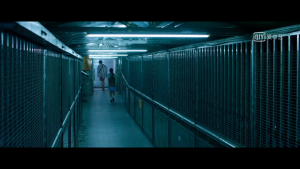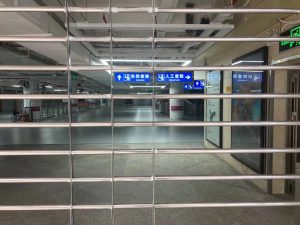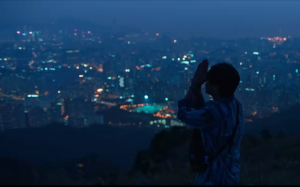LUOHU PORT, LUO HU DISTRICT, SHEN ZHEN
The Crossing is about a 16-year-old girl called Liu Zipei, who studies in Hong Kong but live in Shen Zhen. Two cities, two lives, two identities. She is a secondary student during the day, but in the evening, she becomes a parallel trader. The film delves into the dilemma that the protagonist faced and sheds light on the parallel trading issue, tighten the conflicts of identity in a dramatic way.
The only legal way to travel between two cities is to pass the port. It is an indispensable part of the protagonist’s life. It serves as a bridge between two cities but also a barrier. I passed it every day when I was a secondary school student too; when I went home late, it gave me a sense of security because it was bright, wide, and guarded. But in the film, it is presented exactly the opposite way: Narrow path, dim light, the building and the crowd are suppressive. The port is no longer a guard, but a judge in the film, making Shen Zhen a place that the protagonist does not want to get back again.


Left: Bridge near the LuoHu Port, Shen Zhen, blocked due to the pandemic. Scenes from The Crossing 2018, directed by Bai Xue. Right: shot at No.1 bridge of the LuoHu Port, Shen Zhen.
The city in the film is monotonous, just like the cross-border student’s life: They travel between home and school through the port. It is more obvious when it comes to the shots taken in Shen Zhen. Many static shots are used, focusing on the protagonist only, blurred the city all the way. On the contrary, shots taken in Hong Kong are clear, vivid, and always involve the mass and the movement. It is a symbol of the identity of the protagonist. She lives in Shen Zhen only because she lives there. However, she gains nothing from this prosperous metropolis as her broken family provides inadequate emotional and financial support. Life in Shen Zhen is so vague and bored that everything except her home and the private space where the trade happens is unrealistic, meaningless for her.

The blurred background, The Kowloon Peak, indicates the distance between the protagonist and the city. Scenes from The Crossing 2018, directed by Bai Xue.
Does she belong to Hong Kong because of this? Unfortunately, no, because she does not live there. In fact, all crucial turning points in the film happen away from the city, such as the yacht, the rooftop, and the warehouse of parallel traders. She never actually lives in any of both cities. She lives between. That’s why the port is important and presented in the way mentioned above. Every time she passes through the dangerous port, she gains trust and care from her ‘collages’, creates her identity and value by earning money. In such a distorted way, she makes an effort to get things that she can’t find in two cities, that is, the feel of ‘home’.
All in all, the film seems to hold a negative attitude toward the protagonist’s struggle. The dilemma she faced does not enhance at all. The identity as a parallel trader that builds around the port is unstable, which vanishes at the end of the film. Once the port exists, the issue will never be solved, and the ‘blue’ filter throughout the film will not fade away.
Leung Kui Ming, UID: 3035784796
Your piece shows an in-depth analysis of the film – the camera, tone, and scene composition, and matching these elements with the mental state of the protagonist Liu. You made meticulous observation of the in-between spaces, or the non-places and explained it with reference to Liu’s life. What are the characteristics of the in-between spaces you mentioned? To further enhance your piece, you may bring in concepts of place and space to anchor your discovery.